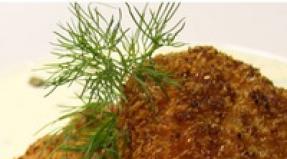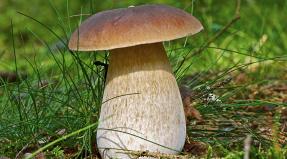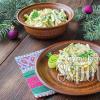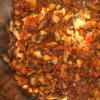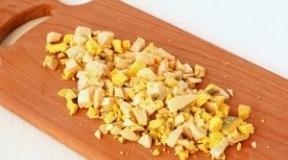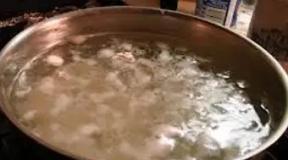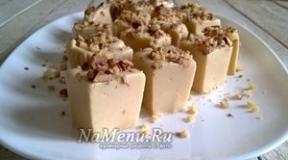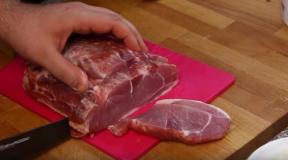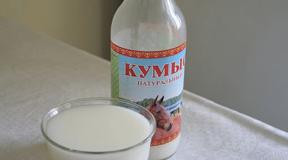Pickling crispy gherkins for the winter. How to pickle gherkins with taste like in a store How to salt gherkins for the winter
Gherkins are small-fruited vegetables of such a variety as "Sowing Cucumber". At the same time, gherkins are often called any varieties of cucumbers that have barely grown in the garden.
At the same time, these miniature fruits (standard length - no more than 4 centimeters) are very useful and original in taste. Housewives use them in a variety of dishes, but usually they are marinades for the winter. Crispy, juicy and low-calorie cucumbers will surprise both family members and guests.
Gherkins contain vitamins such as B9, B6, C, PP, as well as macronutrients - fluorine, iron, iodine, microelements - potassium, calcium, magnesium, sodium.
For real gourmets, we also have recipes for cooking and, as well.

According to this recipe, our cucumbers are crispy, like freshly picked from the garden. A drop of vodka in brine is perfect for a hangover after the New Year holidays.
In addition, such a recipe will allow you to keep rolled up jars of cucumbers in the room.
For a three-liter jar you need:
- gherkins;
- 3 bay leaves;
- 4-5 currant leaves (it is better to use black currants);
- black peppercorns - 6 peas;
- 4 cloves of garlic (we take medium sizes);
- dill seed with umbrellas - 3 pieces;
- bunch of parsley.
Marinade for gherkins:
- water - 1.5 liters;
- coarse salt - 2 tablespoons;
- 2 tablespoons of granulated sugar;
- 1 tablespoon of acetic acid (we take a solution of 70%)
- vodka - 60-70 ml.
Marinated gherkins for the winter - recipe:
- Wash cucumbers and dry. At the bottom of the jar we lay bay leaves, currant leaves, garlic, pepper and parsley. We lay the gherkins tightly, during laying you can shake them so that they themselves lie comfortably. We put dill umbrellas on top.
- We are preparing the marinade. Boil water in a saucepan and add the rest of the ingredients. Cook everything for 2-3 minutes.
- Gently pour the hot marinade into the cucumbers, cover with a lid.
- We put the jar in a larger pot (to fit a three-liter jar), pour water into it and put it on fire. After boiling water, sterilize everything for twenty minutes.
- Close the jar tightly with a lid and leave to cool completely, covering with warm material.
After cooling, the gherkins for the winter will be ready.
Pickled gherkins for the winter without sterilization with cinnamon

A very exquisite recipe for gherkins - with cinnamon. It is rare that someone decides to add such a spice to the marinade, usually using it in baking. But it is worth trying to cook these bittersweet-tasting cinnamon cucumbers.
Prepare cucumbers in a three-liter jar.
We will need:
- fresh gherkins 3-3.5 kg. (in fact, you will need as many of them as you can put in a jar, if you want less brine, then fewer cucumbers, but you can put them close, then there will be a minimum of brine);
- ground cinnamon - 1 teaspoon without a slide;
- garlic, 4 small cloves;
- hot pepper 1 pod (a small one is enough);
- carnation buds - 7-8 pieces;
- black peppercorns - 5 pieces;
- granulated sugar - 2 tablespoons (table);
- table salt - 2 tablespoons, also tablespoons;
- acetic acid 70% solution - 5 ml;
- water - 1.3 liters.
How to pickle gherkins for the winter:
- Wash the gherkins well and put them in a jar.
- Boil water and pour cucumbers with it. To avoid cracking the jar, pour water into the middle of the vegetables without touching the glass walls. Let the water cool down.
- After cooling, the water must be drained and boiled again.
- While the water boils, we put the remaining products in the jar (salt, sugar, cinnamon, and everything else).
- Pour boiling water again and carefully pour a spoonful of vinegar on top. Screw the jar tightly with a lid.
- We turn over on the lids, cover with a warm blanket (or something warm that can be found at home). After cooling, our workpiece is ready and can be tidied up in a cool place.
Spicy Pickled Gherkins - Hungarian Recipe

According to the Hungarian recipe, cucumbers are the most spicy and sour. A very good appetizer in winter, which diversifies dishes and adds spices to meat and other dishes.
We will need:
- 1 kg. gherkins;
- 2 bay leaves;
- 7 cloves of garlic;
- 8 peas of allspice;
- 4 glasses of water;
- 1 glass of acetic acid 9%;
- 5 tablespoons of sugar (table);
- 2 tablespoons with a slide of salt.
How to pickle gherkins like in a store:
- We sterilize jars. We use another way to sterilize jars - in the microwave. For a modern hostess, this is the most suitable option. To do this, pour a little water into the jar (2-4 centimeters to the bottom), place it in the microwave and leave for 3 minutes at full power. Before sterilization, the jars should be washed well and inspected so that there are no chips or cracks, otherwise the jar may burst.
- We wash the cucumbers and put them in prepared jars along with seasonings. Sprinkle salt and sugar on top.
- At this time, boil water on the stove. Pour the prepared vegetables with boiling water.
- Lastly, pour the vinegar into the jar. Close jars tightly with lids and let cool.
Sharp and crispy cucumbers for the winter after cooling will be ready.
Pickled gherkins recipe for a liter jar

When you want to cook some preparations for the winter, but there is no time and money for gourmet products, this is the most profitable option. All the necessary products can be found in any kitchen, and gherkins can be used from the last harvested crops.
Composition of products:
- 1 kg. gherkins;
- 2 glasses of water;
- 1 cup 6% acetic acid;
- hot red pepper - 1 pod;
- onions - 2 heads;
- 5 garlic cloves;
- salt - 1 tablespoon;
Recipe for marinated gherkins:
- We wash the gherkins, dry them. Pack tightly into liter jars.
- We cut the onion and garlic into rings, clean the pepper from seeds and also cut into rings, if you wish, you can also use half rings (as it is more convenient for you). Add to jars with cucumbers.
- We boil water with salt, after dissolving the salt, add vinegar and remove from the stove - the brine is ready. Let it cool down a little so that it is slightly warm.
- Pour the prepared jars with the cooled brine. Cover with a lid and set to sterilize. To do this, pour water into the pan and put the jar there, boil everything for ten minutes. In order to prevent the jar from suddenly bursting, you can put a napkin on the bottom of the pan.
- We take out the jar, tightly roll up the lid and let it cool.
A very simple and under the power of every housewife, the recipe will delight you with delicious cucumbers.
Pickled gherkins with oak leaves for the winter

Thanks to this recipe, cucumbers will turn out crispy and very tasty. Not unimportant ingredient is the brine - it turns out transparent. In addition, the aroma of brine is reminiscent of traditional blanks in wooden barrels, as in the good old days. Fragrant and without a hard crust gherkins are provided to you.
We prepare products:
- 500 gr. freshly picked gherkins;
- oak leaves, 2 pieces (it is better to take young, not spoiled leaves);
- horseradish leaves - 1 small leaf (we also take those that look fresher);
- dill with umbrellas - 2 pcs.;
- garlic cloves - 2 things (small size);
- black peppercorns - 10 peas;
- 1.5 tablespoons of salt;
- 1 spoon of 9% acetic acid;
- 1 spoon of sugar;
- 0.5 l. water;
- Salt, vinegar and sugar are measured in tablespoons.
The blank is designed for 1 liter.
How to marinate gherkins deliciously:
- Cucumbers should be used fresh, in extreme cases, collected no more than a day ago. We wash them and fill them with water for 3-4 hours.
- We put all the necessary spices in jars, put the greens there, and then the gherkins close to each other.
- Add salt and sugar to water and bring to a boil. After boiling, pour in the vinegar. Then we turn off the brine and let it stand for a couple of minutes. Then we pour it into jars.
- After that, we set the jars to be sterilized for 5-6 minutes. To do this, put them in a pot of water and bring the water to a boil.
- We take our cucumbers out of the water. We close the jar tightly with a lid, let it cool, and put it in a cool room.
Here are our gherkins and ready.
Store-bought pickled gherkins with mustard and horseradish

Such a recipe would be very appropriate for lovers of gourmet dishes of spicy tastes. Mustard marinade removes unnecessary bitterness and acid from the workpiece, making it tender, with a spicy taste.
We will need the following products:
- gherkins 1kg;
- carrots 1 pc;
- onion, young 50 gr.;
- mustard powder 40 gr.;
- a bunch of dill;
- acetic acid (6% solution) - 300 ml;
- ground black pepper - 1 teaspoon;
- 2 bay leaves;
- 1 l. water.
Cooking:
- Wash and dry cucumbers.
- Onion cut into large half rings.
- In a separate bowl, mix mustard powder, finely chopped dill, pepper, finely broken bay leaf, vinegar. Add water and bring to a boil.
- After the water boils, add the gherkins and boil again.
- Take the saucepan off the fire. We put everything in jars and close tightly. Such cucumbers are stored, like any workpiece, in a cool place. But the taste is very unusual.
Young cucumbers, even if they are not gherkin varieties, are very popular on the tables in winter. In addition, collecting them will not be difficult. Due to their small size, they go very quickly into food, both as an independent snack and as a side dish for dishes. In addition, there are many dishes where pickled cucumbers are added - salads, borscht, pickle, etc.
The variety of marinades that exists in our time will help you choose a recipe to your taste that will delight your family or guests. In addition to a simple delicious dish, our mothers used pickled cucumbers as an antipyretic, so the pluses will only increase if another jar of gherkin for the winter appears in your stocks.
Summer is the time of the most active conservation. Most of the preparations fall on the seaming of cucumbers. Crispy, juicy and fragrant gherkins are very loved in the winter. The smaller fruits are eaten plain, while the larger ones are used in numerous salads and other complex dishes.
The simplest and most affordable way of conservation is the three-fill method.
This versatile recipe is perfect for preserving fruit of any size. The flavor of the brine can also be given with other spices by putting horseradish or parsley root in jars, adding thyme grains, cloves or bay leaves. All proportions are indicated for 1 liter jar, but you can vary the amount of spices according to your taste.
Based on this method of blocking, you can get a lot of tasty and crunchy cucumbers in winter, suitable for any use.
Ingredients (per 1 liter jar):
- Gherkins (small cucumbers) - about 600 g
- Garlic - 2-4 teeth.
- Dill umbrellas - 3-4 pcs.
- Cherry leaves - 1-2 pcs.
- Currant leaves - 3-4 pcs.
- Horseradish leaves - 1/3 pcs.
- Peppercorns black and allspice - 4-5 peas
For brine:
- Salt - 2 tsp
- Sugar - 3 tsp
- Vinegar - 1.5 tbsp.
- Water - 300-400 ml
Before plugging, prepare the leaves.
Rinse in cold water and drain dill, horseradish, cherry and currant greens.
2-3 cloves of garlic, peeled and cut into thin slices.
Divide cucumbers in the washing process into 2 groups: medium-sized gherkins and small pickles. This will make it easier to pack them into jars.
In washed jars, start putting spices and herbs for flavor. Place garlic cloves in each jar.
Pick up dill umbrellas according to the volume of dishes.
Arrange on a leaf of cherries: small ones - in jars of 0.5 liters, large ones - 1 liter or more.
Do the same with currant leaves. Small leaves can be put on 2 pcs.
Tear horseradish leaves with your hands.
Pack cucumbers tightly into jars. Start laying with larger ones.
From above, under the very neck, lay the smallest in a tight row.
Fill all jars with boiling water.
Cover the jars with a lid without twisting it. Let stand 20-30 minutes.
Drain the water. And repeat the procedure with hot filling. This will allow you to save cucumbers and herbs from bitterness.
While the jars are sterilized with boiling water, prepare the brine.
We measure all the necessary ingredients.
Pour sugar and salt into hot water. Let them dissolve completely.
Pour vinegar into boiling water. Once it boils for 1 minute, the brine is ready.
Before pouring the brine, put pepper in each jar. There will be enough fragrant 1 pea each, and black - 2 peas each.
Pour the brine into jars up to the very neck.
Screw on the lids tightly.
To check the twist, you need to turn the cans upside down. If water does not seep anywhere, then everything is in order.
Put all the preservation with the lids down, wrap in a blanket. In this form, cucumbers should stand until completely cooled: a day or a half.
Cooled preservation can be hidden in pantries or a basement. After 5-6 days, it is better to check it for swelling of the lids.
Delicious preparations for the winter!
Salted and pickled cucumbers can rightly be called a national Russian snack. This is a great option for cooking a variety of dishes. Everyone's favorite pickle, all kinds of salads, snacks. And simply, by themselves, they perfectly complement not only the dining table, but also a festive feast. Moreover, such an appetizer is not only very tasty, but, moreover, also healthy! Not without reason, if we feel bad, unpleasantly nauseous, just eat one pickled cucumber and everything is removed as if by hand. This is especially known to women who have known the joy of motherhood.
Pickled cucumbers promote appetite and good healthy digestion. In addition, it is a very low-calorie product. Its calorie content is only 11 kcal.
They are also useful in that they help cleanse the body of harmful toxins and toxins. Improve the motility of the gastrointestinal tract, help to cope with constipation.
To make cucumbers not only tasty and fragrant, but also pleasantly crispy, you need to know some of the nuances of their preservation:
- The most important thing is to choose the right vegetables. They should be small, fresh (prickly), not overripe (no yellowness), not too dark, elastic. For pickles, only varieties with pimples are suitable. Smooth ones won't fit.
- Water is a very important ingredient. Ideal spring and well. But you can take an ordinary peeled one. Just not chlorinated. Such water must be settled for a day.
- Before canning, cucumbers must be poured with cold water for 8-12 hours. After that, wash them well.
- All greens should also be thoroughly washed.
Probably, every housewife at least once in her life faced an unpleasant situation when her jar of conservation exploded or the products inside were spoiled. To prevent this from happening, you need to pay careful attention to sterilization and use the following tips:
Back to soaking again. It not only helps cucumbers retain their hardness after heat treatment, but also nourishes them with the necessary moisture. Therefore, they will not so actively absorb the brine. Because they ate a lot of free space in the bank, it will be occupied by air, which can subsequently provoke an explosion. To avoid this, follow these simple rules:
- Wash vegetables and herbs very well. Wash lids and jars before sterilizing them.
- It is very important to hermetically seal everything.
- The use of acid is mandatory. She acts as a preservative.
- It takes a long time to cool cans with preservation. To do this, turn them over on the lid and wrap them well for a day. This will prolong pasteurization and will kill all microorganisms.
Rate the recipe
|
In order not to be misleading, it is better to clarify right away: gherkins are the common name for several varieties of cucumbers with small fruits.
They do not grow larger than the sizes known to many. So small cucumbers of large and medium-sized varieties are not the same as gherkins.
In general, pickling gherkins does not differ much from the same process with ordinary cucumbers.
This dish makes a great winter appetizer when fresh vegetables from the store taste no better than grass and summer is still a long time away.
In addition to the taste reminiscent of warmth, canned "microcucumbers" will also become a source of vitamins.
Store-bought pickled gherkins
In the store, many of us bought those same gherkins in jars, knowing that they are always tasty and will complement almost any table. However, not in all cities of Russia you can buy this product.
Also, some thought about how to cook such an appetizer for the winter themselves. The recipe is quite simple and does not require special ingredients.
For cooking you will need:
- Gherkins;
- Garlic;
- Parsley or dill;
- Allspice;
- Water;
- 9% vinegar;
- Salt.
Banks are sterilized for a couple of 10 minutes.

So, how to pickle gherkins like in a store? We describe the technology. Clean whole vegetables are taken, soaked for 3-4 hours in cold water, which during all this time needs to be changed 2-3 times. Damaged cucumbers will not work, so they are removed.

Peppers, herbs, garlic are placed in a sterile jar, and only then - gherkins.

For brine, you need to fill the pan with water, and when it boils, pour vinegar at the rate of 40 ml per 450 ml of water and boil for 2 minutes. Salt needs 40 g.


Cover with lids and roll up, then let cool upside down and store in the refrigerator.

Recipe for crispy snacks for the winter
Crispy pickled gherkins like in a store from a homemade can in winter - a dream! A delicious addition to meat dishes, an addition to pickles or salads.
At the same time, soft cucumbers will not fit at all and will not be eaten with such pleasure, just like dense and crispy ones.
In order to please the household or guests with such a delicacy, you will need:
- Black pepper;
- 2 teaspoons of sugar;
- 2 teaspoons of salt;
- 2 teaspoons of vinegar 9%;
- A pair of dill umbels with twigs and leaves;
- hot pepper;
- Cherry leaves, bay leaf, currant leaf - 3 pieces each.
Gherkins are poured with cold water for a couple of hours.

In the meantime, jars are being prepared - they must be washed properly and sterilized. At the bottom of each jar are placed the leaves indicated above.

Cucumbers, thoroughly washed, carefully and as aesthetically as possible are laid out in a container. Garlic and pepper are placed in the middle, on top - dill umbrellas. Pour boiling water over it twice to warm it up. The marinade is prepared after that.

The water that was poured into the cucumbers is not poured out, but remains for the preparation of the brine. Boil it, add sugar, salt and add vinegar. The latter can be sent directly to banks. Pour cucumbers with boiling marinade and roll up the lids.

Inverted jars with crispy pickled gherkins are placed and wrapped in a blanket, cooling in this form. You can store preservation in the basement, refrigerator or on the balcony if it's cool.

This is how cooked cucumbers will be crispy and will please everyone who has tried them in the winter.
Recipe for one liter jar
Cooking cucumbers for one jar can be both experimental and specially in a single copy for a present to a special lover of this dish. Or you can take these proportions as the basis for a larger preparation of canned stocks and calculate for a larger number of cucumbers.
So, for pickled gherkins like in a store, you need:
- Gherkins;
- A glass of vinegar 6%;
- Glass of water;
- Two bulbs;
- Five to six cloves of garlic;
- a tablespoon of salt;
- A pod of hot pepper.
Onions need to be peeled and cut into thin rings. Garlic is also peeled and finely chopped. Wash the pepper and remove the seeds.
Gherkins are washed in running cold water and tightly folded into a liter jar mixed with onions, garlic and peppers. Water is brought to a boil, then salt, vinegar are added to it, after which it cools. The gherkins are poured with the cooled brine.
In an enamel pot with water at a temperature of at least 60 degrees Celsius for 10 minutes. Roll up immediately after sterilization, then wrap upside down in a blanket and cool.
This is how one can of slightly spicy pickled gherkins is prepared. If desired, you can not add pepper, but for more flavor, season with cherry, currant or lavrushka leaves.
Gherkins are miniature cucumbers, 3-8 cm long. The fruits are harvested a few days after flowering. Gherkins are closed for the winter in many ways, but in any case they turn out tender and crispy. This preservation is eaten with pleasure by adults and children. Cucumbers closed in this way can be used to make pickles and salads.
For rolling, it is advisable to take small cucumbers, 5-6 cm long. It is convenient to put such fruits in a jar, they are crispy and tasty. To make the preservation really tasty, you should follow these recommendations:
- Small cucumbers do not have to be sterilized, they can be poured several times with hot water.
- To make the taste of the preparation for the winter richer, it is worth adding other vegetables to the cucumbers - peppers, tomatoes, onions and carrots.
- Crispy cucumbers come out only with vinegar, but, in extreme cases, it can be replaced with citric acid.
The appetizer is closed in half-liter and liter jars. In this case, the jar is enough for several meals. It is not worth storing open cucumbers for a long time.

Selection and preparation of the main ingredient
Gherkins are sorted out, leaving only whole and strong fruits. If the cucumbers are uneven, it's okay, these are also suitable for pickling. Pour the vegetables into a large basin and rinse well in cool water, changing the water several times. When washing, it is necessary to remove the inflorescences if they remain on the fruit. After washing, the gherkins are poured with cold water and left for 3 hours.
After that, the cucumbers are transferred to another bowl. You should not wipe them, as they will be filled with hot water several times.
It is necessary to put aside cucumbers that have sluggish or spoiled areas, such fruits can lead to damage to conservation.
Preparation of containers for salting
Small cucumbers are usually salted in half-liter and liter jars. Before starting conservation, the container must be washed well with soda and dried in the oven or in the sun. It makes no sense to sterilize the jars, as they will contain non-sterile greens and cucumbers.
The lids should be wiped with a napkin, and then boiled for 10 minutes. If threaded caps are reused, they are inspected for rust, damaged ones should be replaced.
Methods for salting gherkins at home
Many housewives strive to ensure that the taste of home-made gherkins is no worse, but better than store-bought. At the exit, I want to get crispy, sour cucumbers, smelling of fragrant spices. You can close such preservation according to different recipes, each hostess chooses them to her liking.
Recipe for gherkins for the winter: step by step instructions
Pickled cucumbers can be closed according to a simple recipe. The taste of the finished product will surely please not only the household, but also the guests. To close crispy gherkins, you need to take the following components per liter of water:
- Gherkins - how much will go into the jar.
- Salt - 2 tbsp. spoons.
- Sugar - 3 tbsp. spoons.
- Vinegar 9% - 50 ml.
- Spices - dill umbrellas, currant leaves, cloves and pepper.
Spices are placed on the bottom of the bottles and cucumbers are tightly folded. Boil the water, fill the jars and survive for 15 minutes. Next, the water is drained and boiling water is poured again. After 10 minutes, the water is poured out, sugar, salt, vinegar are added and the brine is boiled. Pour into jars and seal with lids. They cover the preservation with a blanket and soak for a day.
According to this recipe, cucumbers come out crispy, like in a store. If you add small tomatoes to the jar, the preservation will acquire an interesting flavor and aroma.
Without sterilization with cinnamon
If you want something unusual, you can close the cucumbers with cinnamon. They have a pleasant bittersweet taste. For pickling vegetables you will need the following products:
- Cucumbers - 3 kg. There are more or less of them, depending on how much will fit in the jar.
- Cinnamon powder - a teaspoon.
- Garlic - 1 head.
- Hot pepper - a small pod.
- Sugar and salt - 2 tbsp. spoons.
- Vinegar - 80 ml.
- Water - 2 liters.
- Spices.
Cucumbers are stacked in jars. Pour boiling water over and wait 15 minutes. The water is poured out and the bottles are filled with marinade, boiled from water, spices, salt, cinnamon and sugar. Pour a tablespoon of vinegar into each jar and cork with lids.
Salting comes out tasty and fragrant. From this amount of products, 4 liter jars of fragrant snacks come out.
Recipe for a liter jar
Many housewives prefer to pickle gherkins in liter jars. For pickling vegetables according to the classic recipe, you need to take:
- Cucumbers - 600 grams.
- Salt - a teaspoon.
- Sugar and vinegar - according to Art. spoon.
- Spices.
Leaves from currants and cherries, dill branches, garlic and pepper fall asleep on the bottom of a liter jar. Gherkins are laid in rows and boiled water is poured into the container. After 20 minutes, water is poured out, then salt, sugar are poured into each jar and vinegar is poured. Re-fill the vegetables with boiling water and cork.
Wrap the preservation with a blanket and leave to warm up for a day. After that, they are transferred to a cold place.
Spices can be added at your discretion. Many housewives also put a bay leaf.
With oak leaves
Canned cucumbers with oak leaves are very tasty. On a liter jar take:
- Gherkins - 600 grams.
- Salt - a teaspoon.
- Sugar - dessert spoon.
- Vinegar - 20 ml.
- Water - 500 ml.
- Oak leaves.
- Dill.
- Garlic.
Some people do not like the smell of vinegar, in this case the marinade is boiled with the addition of citric acid. For a liter of water, you should take a teaspoon without a slide of lemon. The rest of the ingredients are taken, as in the classic recipe.
with ketchup
For a change, you can pickle cucumbers according to original recipes. Cucumbers with ketchup will not leave indifferent even gourmets. To prepare the workpiece take:
- Gherkins - 3 kg.
- Vinegar and sugar - 0.5 cups each.
- Salt - 2 tbsp. spoons.
- Water - 2 liters.
- Ketchup spicy - 8 tablespoons.
- Garlic - 4 cloves.
- Spices - dill, currant leaves, allspice.
Greens are poured into jars and cucumbers are put there. Pour boiling water, keep warm for 15 minutes and drain the water. The marinade is cooked from the rest of the products, poured into jars and sealed. The jars are turned upside down and covered.
To get the original taste of cucumbers, you can pickle them with apples and carrots. In this case, they are cut into thin slices and placed on the bottom along with greens. Cucumbers are poured 2 times with boiling water and the last time with brine, cooked according to the classic recipe.
with apples
Cucumbers, closed with sweet and sour apples, have an unforgettable taste and aroma. Apples, peeled and cut into pieces, are placed on the bottom of a liter jar, gherkins are placed on top. For the marinade take:
- Water - 0.5 liters.
- Vinegar - an incomplete tablespoon.
- Sugar and salt in a teaspoon.
- Spices - to taste.
Gherkins are first filled with water, and then with brine, the jars are corked and then turned over. Top covered with a blanket.
with gooseberries
With gooseberries, gherkins are closed according to the same recipe as with apples, only unripe berries are poured onto the bottom. Vinegar should be taken less, as the gooseberry gives the brine acid.
in Hungarian
Cucumbers according to this recipe come out spicy and crispy. For the preparation of conservation take:
- Gherkins - 1 kg.
- Water - 1 liter.
- Salt and sugar 2 tbsp. spoons.
- Vinegar - 50 ml.
- Garlic - 1 head.
- Bay leaf.
- Dill.
- Bitter pepper - a piece.
Spices are distributed in jars and filled with cucumbers. Pour in boiled brine and send to be sterilized for 20 minutes. Next, twist the jars with lids and put them upside down, under the covers.
You can not sterilize cucumbers. In this case, the vegetables are poured 2 times with boiling water and only the third time with brine.
Many housewives are interested in recipes for pickled gherkins. Such a blank can decorate any holiday table. Small, crunchy canned cucumbers are a great snack, well suited for inclusion in side dishes and sauces.
Today we will tell you how to cook this wonderfully delicious sunset.
General rules and small nuances
Contrary to popular belief, gherkins are not the fruit of any "special" varieties of popular culture. These are just very young greens of any variety, slightly grown ovaries, plucked 2-3 days after the flower wilts. They should have a thin tender skin, dense crispy flesh without voids and a length of no more than 5-7 cm. ).
Small cucumbers are prepared for home canning in the same way as large ones. They must be kept for several hours in cold water, washed and rid of tails. There is also nothing unusual in the composition of the marinade filling and a possible set of additional ingredients that are put in jars: this is a traditional set of spices and herbal supplements, described in detail in the article "How to Pickle Cucumbers" posted on our website.
Pickling gherkins for the winter at home is no more difficult than canning more “adult” cucumbers, but there are still some differences in the approach to the process. For example, it is believed that young Zelentsy should not be processed by the triple hot pouring method so as not to accidentally "cook" their delicate skin. Therefore, experienced housewives in such cases are limited to double pouring (or single, followed by wrapping). But if desired, the marinade for gherkins can be made a little more “strong” (sour) than for large fruits: the taste of the dense pulp of the ovaries does not deteriorate from this, but only becomes a little sharper. In addition, canned small cucumbers almost always remain crispy.
We have compiled for you a few simple step-by-step instructions for preparing an appetizing and beautiful gherkin appetizer for the winter.
Many housewives use this recipe as a base one, making changes to it according to their own taste. Gherkins are lightly salted, very fragrant, crispy and piquantly spicy.
Output: 3 cans (1 liter volume)
Ingredients:
- cucumbers - about 2 kg (how much will go into jars);
- garlic - 6-9 cloves;
- water - 1.2 l;
- rock salt - 2 tbsp. l.;
- sugar - 1 tbsp. l.;
- acetic acid (70%) - 1.5 tsp;
- vodka - 60 ml;
- dill (umbrellas), horseradish leaves, currants and cherries - 3-6 pieces each;
- dry spices (bay leaf, peppercorns, coriander or mustard seeds, cumin, clove buds, etc.) - optional.
Cooking:
- Gherkins are soaked, washed, their tails are cut off.
- Dry spices and fresh herbs are laid out evenly in pre-sterilized jars. Lay cucumbers in containers as tightly as possible.
- 20 ml of vodka and half a teaspoon of acetic acid are added to each jar.
- Pour the brine into the container to the top. Banks are placed in a pot of hot water, brought to a boil and kept for 10-12 minutes.
- Take the jars out of the water, cork them, turn them over onto the lids and leave to cool.
An appetizer of young vegetables turns out to be very unusual, spicy, but tender. To add spice to canned food or slightly change the taste, you can include pieces of fresh hot pepper, a clove bud or a little cinnamon in the composition.
Output: 2 l
Ingredients:
- cucumbers - about 1.5 kg (how much will go into jars);
- young carrots - 2-3 pieces;
- onion (small heads) - 4 pcs.;
- dill - a large bunch;
- ground black pepper - 2 tsp;
- bay leaf - 4 pcs.;
- water - 1 l;
- vinegar, 6% - 250 ml;
- mustard powder / seeds - 3-4 tbsp. l.;
- sugar - 1-2 tbsp. l.;
- rock salt - 1 tbsp. l.
Cooking:
- Gherkins are washed and rid of tails, carrots are peeled and cut into thin circles, onions - in half rings.
- Dill greens are chopped, bay leaves are chopped into small pieces.
- Dill, bay leaf and black pepper are mixed in a saucepan. Add water, vinegar, mustard powder, salt and sugar and bring to a boil.
- Immerse cucumbers, carrots and onions in a hot marinade and boil for a couple of minutes.
- The vegetables are laid out tightly in prepared jars, filled to the top with marinade, rolled up, turned over on lids and wrapped until cool.
The cooled workpiece must be stored in a cool dark place.
A very tasty and beautiful appetizer, ideal for a festive table. In principle, any berries are suitable for the preparation of such canned food, but seaming is best obtained with gooseberries or currants (black or red). A great option is pickling gherkins with a mixture of these berries.
Output: 3 liter jars
Ingredients:
- cucumbers - about 2 kg;
- berries - 500 g;
- garlic - 3-6 cloves (optional);
- fresh hot pepper - 3 small pods whole (optional);
- water - 1.2 l;
- sugar - 70 g;
- rock salt - 30 g;
- vinegar 6% - 100 ml;
- dill umbrellas, horseradish, currant and cherry leaves, tarragon grass and other spicy greens;
- dry seasonings (bay leaf, black and allspice peas, clove buds, coriander grains, etc.).
Cooking:
- Gherkins are thoroughly washed, their tails are cut off.
- Garlic cloves are peeled.
- The berries are washed, green stalks and (if possible) dry remains of flowers are removed from blackcurrants and gooseberries. Red currants can be placed directly in clusters.
- Green spicy herbs and leaves, as well as hot peppers, are washed in running water.
- All components are laid out evenly in pre-sterilized jars.
- Brine is made from water, salt and sugar.
- Fill the jars with boiling brine to the top, cover with lids and leave for 15-20 minutes.
- Drain the brine into a saucepan and boil it again, then remove from heat and add vinegar.
- Fill the jars with filling to the top, roll them up, turn them over onto the lids and leave to cool.
Each housewife has the opportunity to adjust the taste of such canned food in accordance with her preferences, or try to roll up several options at once. For example, you can do without adding garlic and fresh hot pepper to make the preparation less spicy, or put a couple of pieces of cinnamon sticks in jars (the taste will turn out to be more exotic and spicy). Filling modifications with a different ratio of salt and sugar are possible. But experimenting with increasing the amount of vinegar is probably not worth it, since the berries already contain additional acid.
Video
If you are interested in the topic of the article, we suggest watching a few more video recipes shared by experienced housewives:
Graduated from MGRI them. Ordzhonikidze. By main specialty, he is a mining geophysicist, which means a person with an analytical mindset and diverse interests. I have my own house in the village (respectively, the experience of gardening, gardening, mushroom growing, as well as fussing with pets and birds). Freelancer, perfectionist and "bore" in relation to his duties. Handmade lover, creator of exclusive jewelry made of stones and beads. A passionate admirer of the printed word and a tremulous observer of everything that lives and breathes.
Found an error? Select the text with the mouse and click:
Ctrl+Enter
Do you know that:
The birthplace of pepper is America, but the main breeding work for the development of sweet varieties was carried out, in particular, by Ferenc Horváth (Hungary) in the 20s. XX century in Europe, mainly in the Balkans. Pepper came to Russia from Bulgaria, which is why it got its usual name - “Bulgarian”.
Freezing is one of the most convenient methods for preparing a grown crop of vegetables, fruits and berries. Some believe that freezing leads to the loss of nutritional and beneficial properties of plant foods. As a result of the research, scientists have found that there is practically no decrease in nutritional value during freezing.
Convenient applications for Android have been developed to help gardeners and gardeners. First of all, these are sowing (lunar, flower, etc.) calendars, thematic magazines, collections of useful tips. With their help, you can choose a day favorable for planting each type of plant, determine the timing of their maturation and harvest on time.
Both humus and compost are rightfully the basis of organic farming. Their presence in the soil significantly increases the yield and improves the taste of vegetables and fruits. In terms of properties and appearance, they are very similar, but they should not be confused. Humus - rotted manure or bird droppings. Compost - rotted organic residues of various origins (spoiled food from the kitchen, tops, weeds, thin twigs). Humus is considered a better fertilizer, compost is more accessible.
Natural toxins are found in many plants; no exception, and those that are grown in gardens and vegetable gardens. So, in the bones of apples, apricots, peaches there is hydrocyanic (hydrocyanic) acid, and in the tops and peel of unripe nightshade (potatoes, eggplants, tomatoes) - solanine. But do not be afraid: their number is too small.
Tomatoes have no natural protection against late blight. If late blight attacks, any tomatoes die (and potatoes too), no matter what is said in the description of the varieties (“late blight-resistant varieties” is just a marketing ploy).
It is believed that some vegetables and fruits (cucumbers, stalk celery, all varieties of cabbage, peppers, apples) have a “negative calorie content”, that is, more calories are expended during digestion than they contain. In fact, only 10-20% of the calories received from food are consumed in the digestive process.
Humus - rotted manure or bird droppings. It is prepared like this: manure is piled in a heap or pile, interbedded with sawdust, peat and garden soil. The collar is covered with a film to stabilize the temperature and humidity (this is necessary to increase the activity of microorganisms). Fertilizer "ripens" within 2-5 years - depending on external conditions and the composition of the feedstock. The output is a loose homogeneous mass with a pleasant smell of fresh earth.
Compost - rotted organic residues of various origins. How to do? Everything is put in a pile, a pit or a large box: kitchen leftovers, tops of garden crops, weeds mowed before flowering, thin twigs. All this is interbedded with phosphorite flour, sometimes straw, earth or peat. (Some summer residents add special composting accelerators.) Cover with foil. In the process of overheating, the pile is periodically stirred or pierced to bring in fresh air. Usually compost "ripens" for 2 years, but with modern additives it can be ready in one summer season.
Read also...
- Thai meat with vegetables - a classic recipe with step by step photos of how to cook beef with bell pepper and soy sauce at home
- Soft brushwood with cottage cheese: recipe with photo step by step
- Soft brushwood with cottage cheese: recipe with photo step by step
- Marinade for chicken How to marinate chicken meat for frying




















